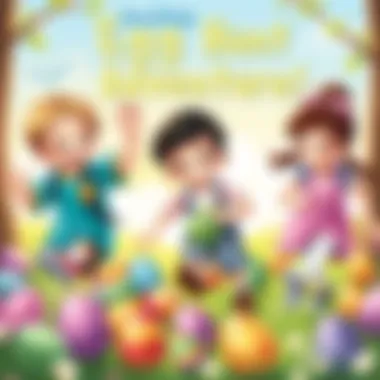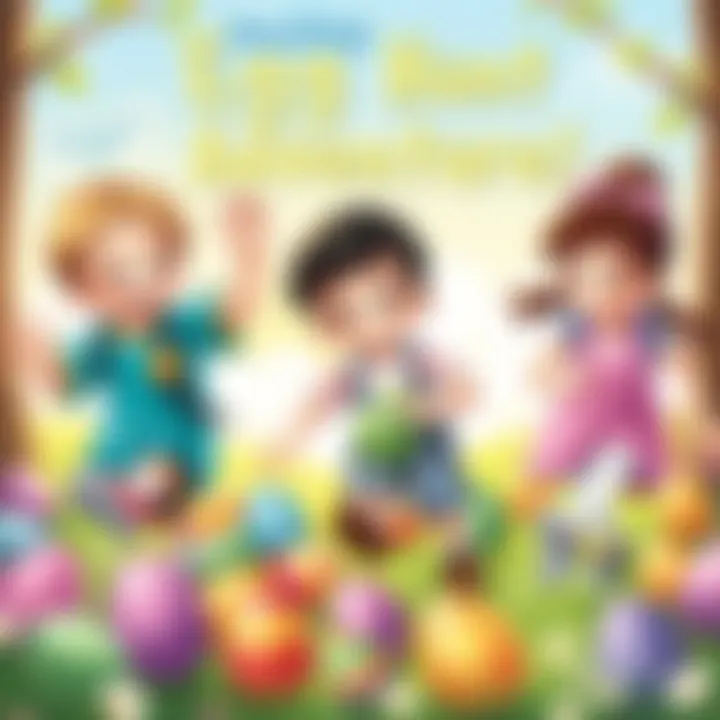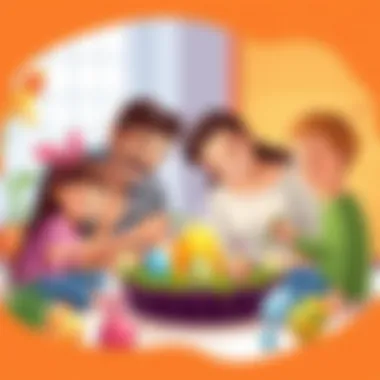Easter Games for Family Bonding and Fun Activities


Intro
Easter isn't just a time for chocolate bunnies and bright decorations; it presents a unique chance to deepen family bonds through engaging activities. As family members gather to celebrate, integrating games into the mix can transform an ordinary holiday into an extraordinary experience. Here, we delve into some interactive learning games, creative DIY projects, and effective strategies that not only entertain but also foster connections within the family. Whether the children are aged three or twelve, every game and activity is designed to stimulate minds and encourage teamwork.
Interactive Learning Games
With an emphasis on playful learning, interactive games can serve as the backbone of a memorable Easter celebration. These games aren't just a means to celebrate; they also weave educational elements into the fun, ensuring that learning happens in an organic and enjoyable way.
Popular Games
Here are some engaging game ideas to consider:
- Easter Egg Hunt with Clues: Instead of the usual candy-only hunt, incorporate riddles leading to hidden eggs. This enhances critical thinking.
- Easter Bingo: Create bingo cards featuring holiday-related images or vocabulary words, encouraging kids to learn as they play.
- Crafty Scavenger Hunt: Give children a list of items found in nature or around the house to collect, fostering teamwork and creativity.
Description of Top Educational Games
- Math Egg Toss: A simple yet effective game where kids toss a ball and answer math questions written on eggs before catching it.
- Story Time Relay: Family members take turns adding to a story with a sentence, prompting imagination and language skills.
- Science Experiment Kits: Engage kids in hands-on science through fun experiments like creating DIY slime or making egg-based volcanoes.
Benefits of Playing Educational Games for Kids' Cognitive Development
Engaging children in educational games cultivates essential skills:
- Critical Thinking: Solving problems fosters a sharper mind.
- Collaboration: Working with others promotes social skills and communication.
- Creativity: These activities often encourage thinking outside the box, a crucial skill in today's world.
Game Reviews
When selecting games, it is vital to scrutinize their educational value and gameplay quality. Some standout recommendations include:
- Osmo Genius Starter Kit: Merges physical play with digital interaction, building foundational skills across multiple subjects.
- Gravity Maze Marble Run: Combines logic and engineering to challenge kids as they navigate a marble through a maze.
- Rush Hour: A code-breaking game that hones spatial reasoning and planning skills.
Comparison of Gameplay and Learning Outcomes
Upon reviewing these games, it’s clear that they aren't merely entertaining; they systematically enhance learning experiences. For instance, while Osmo encourages collaboration, Gravity Maze focuses on individual problem-solving, demonstrating that different games cater to various aspects of cognitive development.
Creative DIY Projects
In addition to games, DIY projects present a unique way to spark creativity in children. These activities require minimal materials and can be tailored to suit family interests.
Step-by-Step Guides
- Easter Egg Decorating: Use natural dyes from fruits and vegetables for eco-friendly colors. Simply boil the eggs with the dyes for vivid, personalized results.
- Bunny Masks: Cut out shapes from cardboard and decorate with cotton balls, construction paper, and crayons. This simple project fosters artistic expression while creating a tangible connection to the holiday.
Craft Ideas
- Eggshell Planters: Recycle old eggshells and fill them with soil and seeds. Kids can learn about nature while monitoring their plants' growth.
- Holiday Garland: Create a garland using drawings or cut-outs of Easter-themed figures. Hang it as a festive decoration that the whole family contributed to.
For additional insights into educational topics, you can explore resources such as Britannica or National Geographic Kids. Learning can indeed be a delightful journey, especially when it's shared with loved ones.
Prolusion to Easter Games
Easter is more than just a holiday marked by chocolate bunnies and egg hunts; it’s an opportunity for families to come together and create cherished memories. This article delves into a variety of Easter games designed to engage family members of all ages, from toddlers to parents. By incorporating play into quality time, families can foster connections that go beyond the day itself.
The Importance of Family Interaction
As the saying goes, "A family that plays together stays together." Family interaction is vital for strengthening bonds and building a supportive environment. During Easter, many families find themselves caught up in various tasks: cooking, decorating, and preparing for guests. Adding games to the mix enables families to step away from the hustle and bustle, allowing for moments of laughter and joy.
Games provide a structured way to engage with one another, breaking down barriers and prompting open communication. Especially for young children, these interactions can nurture a sense of belonging and self-esteem. It’s not just about the games but also the moments shared during these activities that help weave the fabric of family relationships.
Learning Through Play
Playing is not just for amusement—it is a fundamental method through which children learn. When kids participate in Easter games, they gain invaluable skills without even realizing it.
- Cognitive Development: Various games involve problem-solving and decision-making, benefiting the brain's development. For example, figuring out how to navigate through an egg hunt encourages critical thinking.
- Social Skills: By engaging in team games, children learn to cooperate, share, and resolve conflicts. These skills set a foundation for future interactions outside the family circle.
- Motor Skills: Many activities require physical movement, enhancing hand-eye coordination and gross motor skills.
In essence, learning through playful activities not only makes education enjoyable but also embeds lessons that last a lifetime. When families incorporate these activities into their Easter celebrations, they cultivate an environment of continuous learning and connection.
Outdoor Easter Games
Engaging in outdoor activities during Easter is not only a time-honored tradition but also a wonderful way to unite family members in shared experiences that foster connection and joy. The fresh air, combined with active play, nurtures physical health and emotional well-being. Outdoor games encourage children to explore their surroundings, ignite their imagination, and cultivate teamwork skills—all while providing plenty of fun.
In this section, we will delve into specific outdoor Easter games that can bring families together, enhance learning, and create lasting memories.
Egg Hunts: A Classic Tradition
Planning the Hunt
Planning an Easter egg hunt is crucial in transforming a regular day into a cherished memory for the family. This activity offers a blend of excitement and curiosity, making it popular among kids of all ages. A key aspect of planning the hunt is choosing a suitable location; parks, backyards, or even community gardens can provide ample space for searching. Additionally, the number of eggs to hide should match the age group of participants, striking the right balance between challenge and fun.
Key characteristics of planning an egg hunt include:


- Diversity in Egg Types: Use plastic eggs filled with diverse goodies such as candies, toys, or even small notes with tasks or riddles.
- Age-Appropriate Hiding Spots: Select hiding places that are easy for younger kids to find, while offering more challenging spots for older ones.
However, one should consider carefully how long the hunt will last. Too short may leave kids unsatisfied, but making it longer should ensure it remains engaging without it turning tedious.
Incorporating Challenges
Incorporating challenges into an egg hunt elevates the experience from a simple search to an adventurous quest. By including riddles, clues, or even a scavenger hunt format where participants must complete specific tasks to earn their next clue, the hunt becomes a little more engaging. This not only expands the fun but also promotes critical thinking.
Unique features of incorporating challenges include:
- Thematic Elements: Create a theme around the hunt, such as pirates or detectives, which adds excitement and creativity.
- Team Challenges: Mixing kids into teams can foster cooperation and bonding, enhancing the family connection.
While challenges may make things more complicated, they also ensure that everyone is engaged, making for a memorable day.
Easter Relay Races
Organizing Teams
Organizing teams for relay races can ignite a spirit of camaraderie and friendly competition among family members. Choosing teams randomly or based on age can balance the competition and encourage kids to mingle with relatives they don’t often interact with. Relay races are easily adaptable, ensuring all participants can contribute according to their abilities.
Benefits of organizing teams properly include:
- Inclusivity: Ensuring everyone gets a chance to participate helps foster a sense of belonging within the family.
- Skill Development: Kids enhance their coordination and teamwork while having fun together.
Nevertheless, one should be mindful of ensuring safety and fairness throughout the race, as spirited competition can sometimes lead to momentary frustrations.
Setting Up Obstacles
Setting up obstacles is a fantastic way to take a simple race and transform it into an exhilarating challenge. Simple items like cones, hula hoops, or even water balloons can become part of the race path, providing physical challenges that engage children in active play. This can also lead to hilarious moments as family members navigate through the setup.
Key aspects of setting up obstacles include:
- Creativity in Design: Designing an obstacle course that features unique challenges, such as crawling under tables or skipping over ropes, can add layers of fun to the competition.
- Safety Measures: Always keep safety in mind; ensure materials used are safe and adjustable for various skill levels.
Overall, when done thoughtfully, obstacle courses can enhance the joy of competition while allowing every participant to shine. As such, outdoor Easter activities like egg hunts and relay races not only bring families together but build lifelong memories.
Indoor Easter Games
Indoor Easter games offer a wonderful way to gather the family together when the weather isn't playing along. They provide not only entertainment but also create opportunities for interaction and bonding in a comfortable setting. As families look for engaging ways to celebrate the holiday without stepping outside, these games become invaluable. When crafted thoughtfully, indoor games can enhance creativity, cooperation, and even critical thinking.
Easter-themed Board Games
Game Variety
The world of Easter-themed board games is as diverse as a box of assorted chocolates. From classic games like Easter Bingo to more intricate ones that involve strategy and risk, there’s something for everyone in the family. The key characteristic of this variety is its ability to cater to different preferences and ages, ensuring no one feels left out. This variety contributes to the overall goal of boosting family connections while offering a light-hearted competitive spirit.
One unique feature of these games is their educational aspect; many incorporate themes of counting or problem-solving that can subtly engage younger children in learning without them even realizing. While one might argue some games could be overly complicated for younger players, the adaptability of rules or game mechanics often allows for where older kids can guide the younger ones, promoting teamwork.
Rules for Family Inclusion
Establishing rules that focus on family inclusion is crucial to ensure everyone gets a fair shot at fun. A common approach is to modify existing game rules: for instance, allowing younger siblings to take two turns in a row or creating team play that mixes ages. The standout characteristic here is flexibility, which enables families to tailor the game experience to their unique dynamics. This customization stands as a beneficial choice, as it strengthens family bonds, ensuring that no one feels sidelined, thus reinforcing group unity.
A unique feature in these rules could be the introduction of family roles—for instance, a designated "game master" who helps set the pace, especially helpful with younger kids in the mix. However, there might be disadvantages, like potential friction if not everyone agrees on rule adaptations. It is important to communicate and ensure that everyone buys into the spirit of the game.
Crafting Competitions
Materials Needed
Crafting competitions can bring out the inner artist in every family member, turning a simple gathering into creative chaos. Materials can range from colored paper, scissors, and glue sticks to recycled materials from around the house. The key advantage of these materials is their accessibility; most households have basics lying around. Using such familiar items fosters a sense of comfort while encouraging imaginative creations.
The unique feature of this aspect is that it allows for personalization—everyone can express their individuality while contributing to a collective theme, like Easter. However, one potential drawback could be a significant cleanup afterward, which can deter some from fully participating. Yet, the fun, laughter, and sometimes chaotic creativity often outweigh the post-craft mess.
Judging Criteria
Establishing clear judging criteria can add another layer of excitement and fair play to crafting competitions. Criteria can include creativity, effort, and adherence to the theme, making it easier for families to assess each creation fairly. The standout feature of setting these criteria is the promotional of constructive feedback, encouraging children to embrace their creativity and improve without feeling criticized.
This advantage lies in fostering a growth mindset—where learning and creativity are celebrated, and imperfections are viewed as opportunities to grow. However, care must be taken to present judging in a way that promotes inclusion rather than competition. This can be particularly sensitive with kids; emphasizing fun rather than making everything a contest can enhance the experience and maintain harmony within the family.
In summary, indoor Easter games enhance family connection and learning, providing fun-filled activities regardless of outside weather conditions. The incorporation of varied board games and fun crafting competitions offers a delightful way to celebrate the holiday while reinforcing the importance of family interaction.
Educational Activities for Easter
Educational activities during Easter provide a wonderful opportunity to blend fun and learning for families. These activities utilize the festive spirit of the season to keep children engaged while enriching their knowledge. It’s more than just games; it’s a way to teach critical skills in a playful, informal setting that resonates with kids. The emphasis on fun through education, especially in the context of holidays, creates lasting memories as families learn side by side.
Harnessing the joy of Easter, educational activities enable parents to facilitate an environment of curiosity and wonder. It also encourages children to express their creativity and solidify their understanding of concepts like math and science without them realizing they are being educated. Activities like egg counting and science experiments involve practical application of these subjects, allowing children to see the relevance of what they learn in school.
Math and Counting Games


Egg Counting Activities
Egg counting activities introduce children to basic mathematics in a hands-on way. With the excitement of Easter, these activities transform the mundane task of counting into an engaging challenge. Making it a game boosts not only counting skills but also enhances their ability to think critically. What’s unique about egg counting is the tactile experience; handling actual eggs—be they real or plastic—helps younger children grasp numbers better. The colorful nature of eggs can enchant and motivate children to engage more fully in the activity.
Benefits of egg counting include improved numeracy skills and enhanced ability to follow instructions, all while working collaboratively with siblings or older family members. However, the challenge comes when trying to keep the activity structured for kids with shorter attention spans. Parents can combat this by mixing in small rewards for milestones throughout the activity.
Math Puzzles
Math puzzles serve as an intriguing alternative to traditional learning methods. These puzzles encourage logical thinking and problem-solving skills among children. In the context of Easter, math games can be themed around popular icons associated with the holiday—like bunnies or eggs—adding an engaging twist to otherwise simple math tasks. Since youngsters often enjoy solving puzzles more than doing worksheets, this can significantly boost their willingness to engage.
The characteristic feature of math puzzles is their flexibility—parents can find puzzles suited for various age levels, from simple addition to more complex arithmetic, adapting easily as the child grows. The downside, however, is that if a puzzle is too challenging, it may lead to frustration, causing a child to lose interest. Softening that blow by ensuring a varied selection is key to maintaining engagement, especially for different skill levels.
Science Experiments
Building Egg Drop Contraptions
The egg drop challenge is a classic experiment that speaks volumes about physics and creativity. In essence, children design structures to protect an egg from breaking when dropped from a height. This activity introduces children to concepts like gravity, impact, and material science in an approachable way. The hands-on aspect of constructing a contraption stimulates their problem-solving abilities and encourages teamwork if approached in groups.
The highlight of this challenge is the creative liberty children have while designing their contraption, using household items like straws, tape, and cardboard. However, the requirement for careful planning and critical thinking can be daunting for younger kids. Parental guidance in ensuring safety and assisting with construction ideas can alleviate stress and make the experience enjoyable.
Coloring Eggs with Natural Dyes
Coloring eggs with natural dyes is an artful and educational approach to learning about chemistry and creativity. This activity allows families to experiment with various everyday items like beet juice, turmeric, and spinach to create vibrant colors. The process teaches kids about the science of colors while they enjoy the twofold experience of crafting and celebrating a tradition.
One perk of using natural dyes is that it introduces children to the concept of sustainability, often sparking conversations around environmental consciousness. On the flip side, natural dyes can sometimes be less vibrant compared to commercial dyes, which may be a disadvantage if you're aiming for bright colors. However, the alternative of more muted tones offers an opportunity to discuss topics like mixing colors and how different sources affect the shade of the dye produced.
Creative Easter Crafts
Easter is a time for creativity and expression, especially through the lens of crafting. Engaging in Creative Easter Crafts not only brings families together but also nurtures the imagination of children. These activities allow for sharing thoughts and ideas, enabling families to foster deeper connections while celebrating the season. By working on crafts, children learn to think outside the box, which is a skill that can be beneficial as they grow. Whether it's making decorations or personalized gifts, each craft serves as a tangible reminder of family unity during the holiday.
DIY Easter Decorations
Using Recycled Materials
Using recycled materials to create DIY Easter decorations comes with a big environmental benefit. It teaches kids about sustainability and the value of repurposing everyday items. Rather than tossing away unused paper or old containers, families can turn them into colorful Easter eggs or cheerful bunnies. This approach is not just clever; it encourages kids to see potential in what they might usually overlook.
- Saves Money: Crafting with recycled materials is generally cost-effective.
- Promotes Creativity: Kids can think creatively when they're given materials that need a second life.
However, this method could pose some challenges. Not every family might have a nice collection of recyclable products, and sometimes what you find may not fit the craft idea perfectly. Yet, when families collaborate, they can also brainstorm together, leading to imaginative solutions.
Family Collaboration Techniques
When it comes to crafting, the beauty of Family Collaboration Techniques shines through. Collaborating on Easter crafts allows families to share responsibilities and ideas. For instance, one member can focus on painting while another handles assembly. This not only makes the process smoother but also enriches the final product, combining various artistic expressions into one piece.
- Builds Teamwork: Working side by side fosters not only creativity but also reinforces the notion of teamwork.
- Strengthens Bonds: Families create memories through shared tasks, which contributes to stronger relationships.
The unique feature of this approach lies in the shared experience, where each family member leaves a personal touch on the finished piece. On the downside, it might lead to occasional disagreements on design ideas. Nonetheless, these discussions often provide valuable lessons in compromise and cooperation.
Egg Decorating Techniques
Traditional vs. Modern Styles
The choice between Traditional vs. Modern Styles of egg decorating can enhance the crafting experience. Traditional methods, often passed down through generations, imbue a sense of history and cultural significance. These can include techniques like dyeing with natural colors or intricate designs using wax.
On the flip side, modern decorating styles incorporate new materials such as stickers, glitter, and even paint pens. These allow for an endless array of creative possibilities, encouraging kids to let their imaginations run wild.
- Traditional Techniques: Maintain cultural heritage and can be enriched with stories told through the ages.
- Modern Techniques: Offer endless options and cater to diverse preferences, making it easier for everyone to participate.
The downside of focusing solely on traditional styles might limit the child’s creative expression. Conversely, modern methods can sometimes lack meaning or the deeper connection that traditional crafts offer.
Safety Tips for Kids
When engaging in any Easter craft, particularly those involving egg decorating, Safety Tips for Kids must come to the forefront. Whether it involves paints, dyes, or other crafting tools, ensuring a safe crafting environment is critical. Always choose non-toxic materials and supervise young children with small or sharp objects.
- Non-Toxic Options: Ensure that all materials used are child-safe and easily washable.
- Supervision: Keep an eye on younger kids, especially when they are handling potentially dangerous tools.
Implementing these safety practices is not just wise but also sets a good example for kids on the importance of being cautious while being creative. The downside may be the slight limitation of using only specific products, but the benefits far outweigh these inconveniences.
Using safety measures not only protects children but teaches them valuable lessons about responsibility as they engage in creative play.
Rhythmic and Musical Games
Incorporating rhythmic and musical games into Easter activities not only spices up the celebrations but also nurtures important skills in children. Engaging in these activities helps promote teamwork, boosts creativity, and enhances cognitive abilities. Music and rhythm can stir emotions and create a lively atmosphere, essential for creating unforgettable family memories.
Easter Sing-Alongs
Selecting Appropriate Songs


Choosing the right songs for Easter sing-alongs is essential for ensuring everyone enjoys the experience. Family members of all ages can participate, but it's important to select songs that resonate with both older generations and the little ones, creating a bridge of connection among them. Familiar tunes, such as "Here Comes Peter Cottontail" or traditional hymns like "Easter Parade," can work wonders.
Songs that incorporate themes of spring, renewal, and family are particularly fitting. The chosen songs usually carry upbeat melodies, inviting everyone to join in. Incorporating some catchy lyrics helps kids easily remember the songs, making them feel part of the experience. However, over-repetition of the same tune can lead to disinterest among some family members, so switching it up with different songs might be a good approach.
Incorporating Movements
Including movements along with singing adds an engaging layer to the Easter sing-alongs. Simple hand gestures or dance steps that match the rhythm can spark excitement among children. This physicality encourages more active participation, allowing kids to channel their energy productively. Movements can range from gentle swaying for soft ballads to lively hops for more energetic songs.
The unique feature of this aspect lies in its dual benefit: it not only enhances physical coordination but also reinforces learning through movement. However, it’s important to consider the physical abilities of all family members. Some may not feel comfortable moving physically; therefore, ensuring everyone’s included, such as by offering seated versions or adaptations of the dance is key to full participation.
Musical Egg Hunt
Strategies for Engagement
Implementing strategies for engagement during the musical egg hunt transforms a simple search into a memorable adventure. One effective approach involves hiding eggs in a manner that corresponds with musical cues. For instance, once the music stops, participants have a designated time to scramble and find eggs. This not only creates a sense of urgency but also keeps the hunt exciting.
Interactive elements, such as adding clues in the form of melodies or rhythm patterns, can heighten engagement. Children love challenges, and the thrill of finding an egg that leads to another clue to a surprise adds layers of fun to the game. However, care must be taken not to make it overly complex, as younger children may become frustrated and lose interest.
Integrating Music Education
Incorporating music education into the musical egg hunt offers valuable lessons wrapped in fun. Simple tasks relating to rhythm or melody, like identifying the correct beat to time their searches, infuse educational elements seamlessly into play. This approach encourages kids to develop an ear for music, understanding basics like tempo and pitch while engaging with their surroundings.
The unique advantage of this characteristic is that it lays a foundation for appreciating music beyond the immediate game. While it stimulates creativity, care should be given to maintain balance so it feels more like a game and less like a classroom lesson. Too much focus on education could diminish enjoyment, which is ultimately the goal of the activities.
By blending rhythm and music with Easter games, families create lasting bonds through enjoyment and learning. A simple egg hunt turns into a lesson in coordination, alongside making joyous memories together.
Incorporating Technology in Easter Games
In recent times, the role of technology in family activities has dramatically changed how we engage with one another, especially during festive occasions like Easter. By incorporating technology into Easter games, families can connect in innovative ways, making the celebration more interactive and engaging. This section tackles the benefits and considerations of using technology during Easter festivities.
Using Apps for Interactive Learning
Recommendations for Educational Apps
When looking for educational apps, a few stand out as both beneficial and engaging for kids. One such app is Khan Academy Kids, which not only offers a plethora of learning materials but also combines gameplay and education seamlessly. It encourages kiddos to learn math, reading, and social skills through fun, interactive methods. Another great option is Endless Alphabet, where kids learn vocabulary through delightful animations and sounds, making the process fun.
The recommendation here is to choose apps that promote interaction and depth rather than passive consumption. The key characteristic of these educational apps is their ability to adapt to each child's learning pace. This customization offers a unique feature ensuring children don’t feel overwhelmed. While there might be concerns about screen time, with these apps, the focus is clearly on learning, making them a valuable addition to the Easter experience.
Promoting Healthy Screen Time
Discussing healthy screen time is particularly important, especially during festive times when children may be more likely to spend longer on devices. Establishing ground rules around usage can help balance fun with learning. For instance, while exploring educational apps, ensure that kids take regular breaks to engage in outdoor or offline activities.
A key aspect of promoting healthy screen time is the emphasis on quality over quantity. By selecting apps wisely and monitoring usage, parents can make the most of technology. One unique feature in this approach is creating a blended schedule that incorporates both screen time and face-to-face interaction. This mix has shown to facilitate better connections among family members, creating an atmosphere rich in communication and bonding.
Virtual Easter Gatherings
In today's interconnected world, virtual gatherings have become a popular solution for families, especially when they can’t gather in person. During Easter, these online meetups create opportunities for family members separated by distance to participate in the festivities.
Planning Activities Online
Planning online activities for Easter not only brings the family together but also revolutionizes traditional celebrations. Think of games like online trivia, virtual egg decorating contests, or even a digital scavenger hunt that can be done via video call. One advantage of such an approach is that you can leverage existing platforms like Zoom or Google Meet, which are user-friendly.
The distinctive feature of planning activities online is the flexibility it offers. You can engage various family members regardless of their location, making it easier to include everyone in the celebrations. Nonetheless, there is a downside as well; technical difficulties and connectivity issues may arise, possibly disrupting the flow. However, with careful preparation, these can be minimized.
Engaging Remote Family Members
Engaging remote family members can be challenging but also rewarding. By encouraging them to join in, you validate their place in your family dynamics, even from afar. You can incorporate live challenges, like an egg hunt where participants must find pre-hidden items in their homes and show them on camera. This creates an atmosphere of competition and engagement.
A notable characteristic of engaging those far away is that it promotes inclusivity. No longer are holidays limited to those who can physically attend. However, one must be cautious; while it’s nice to include everyone, not all elder relatives may be tech-savvy, which could cause some frustration.
Technology can be a bridge, connecting minds and hearts, no matter the distance.
In summary, incorporating technology during Easter not only enriches the festivities but fosters a sense of inclusion and learning among families. It transforms this age-old tradition into a modern experience that remains engaging and educational.
Culmination: Building Lasting Memories Through Games
In the hustle and bustle of life, moments spent as a family can sometimes slip through our fingers. Engaging in Easter games serves not just as a pastime, but as a significant opportunity to cultivate lasting memories. These playful moments foster connection among family members, creating a safe space where laughter and joy thrive. The importance of this cannot be overstated, as these connections can help strengthen relationships, communication, and mutual understanding.
When families embark on playful activities together, they share experiences that contribute to a sense of belonging and unity. Games like egg hunts or crafting competitions spark creativity and collaboration, nurturing bonds in a way that only shared experiences can achieve. The joy and excitement evident in the smiles of both children and adults during these moments are the stitches that hold family fabric together.
"Play is the highest form of research." – Albert Einstein
This quote resonates deeply when we consider how games encourage learning and development. Various activities not only promote familial bonds but also instill essential skills in children, ensuring that these times are valuable beyond mere fun.
Reflecting on Family Connections
Every game played during the Easter season can serve as a reminder that family connections are vital. Engaging activities encourage open dialogue, sharing of ideas, and strengthen the family unit as a whole. Reflecting on these moments offers a chance for families to recognize their unique dynamics.
Understanding each member’s interests and strengths through games can pave the way for deeper conversations. For example, a simple crafting competition can showcase individual artistic flair and provide insights into personalities, helping enhance emotional intelligence among family members. By witnesing each other’s creativity or teamwork during games, families further deepen their ties.
Encouraging Continuous Learning and Play
Easter games are not merely a seasonal event; rather, they provide a gateway to continuous learning. The skills developed during these fun activities lay the foundation for future growth. Incorporating games into family time encourages children to embrace learning outside the traditional classroom setting.
Through play, children become problem solvers, quick thinkers, and effective collaborators. For instance, math-oriented egg-counting activities can seamlessly blend learning with enjoyment, demonstrating that education can be both engaging and informative. Moreover, when families actively foster a culture of play, they instill a lifelong love for learning, encouraging children to experiment, explore, and question the world around them.















